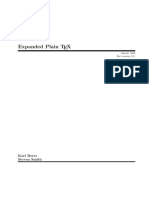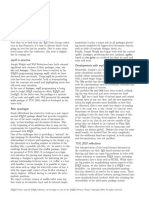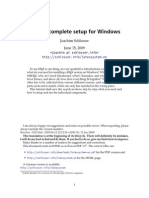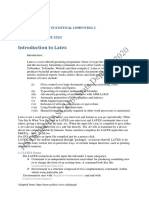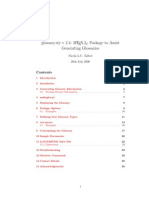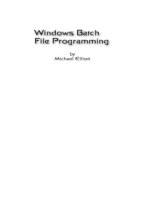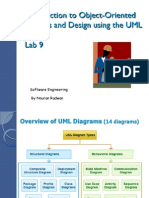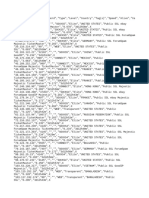Latex Newslatter 2005
Latex Newslatter 2005
Uploaded by
Mohammad Nasir AbdullahCopyright:
Available Formats
Latex Newslatter 2005
Latex Newslatter 2005
Uploaded by
Mohammad Nasir AbdullahOriginal Description:
Original Title
Copyright
Available Formats
Share this document
Did you find this document useful?
Is this content inappropriate?
Copyright:
Available Formats
Latex Newslatter 2005
Latex Newslatter 2005
Uploaded by
Mohammad Nasir AbdullahCopyright:
Available Formats
LATEX News
Issue 17, December 2005
Project licence news
Updates of required packages
The LATEX Project Public License has been updated
slightly so that it is now version 1.3c. In the warranty
section the phrase unless required by applicable law
has been reinstated, having got lost at some point. Also,
it now contains three clarifications: of the difference
between maintained and author-maintained; of the
term Base Interpreter; and when clause 6b and 6d
shall not apply.
Following requests, we now also provide the text of
the licence as a LATEX document (in the file lppl.tex).
This file can be processed either as a stand-alone
document or it can be included (without any
modification) into another LATEX document, e.g., as an
appendix, using \input or \include.
Several of the packages in the tools bundle have been
updated for this release.
The xspace package has some new features. One is an
interface for adding and removing the exceptions it
knows about and another is that it works with active
characters. These remove problems of incompatibility
with the babel system.
In LATEX News 16 we announced that some packages
might begin to take advantage of -TEX extensions on
systems where these are available: and the latest
version of xspace does just that. Note also that fixltx2e
will make use of the facilities in -TEX whenever these
are present (see below).
The calc package has also been given an update with
a few extra commands. The commands \maxof and
\minof, each with two brace-delimited arguments,
provide the usual numeric max and min operations.
The commands \settototalheight and
\totalheightof work like \settoheight and
\heightof. There are also some internal improvements
to make calc work with some more primitive TEX
constructs, such as \ifcase.
The varioref package has acquired a few more default
strings but there are still a number of languages for
which good strings are still missing.
The showkeys package has also been updated slightly
to work with more recent developments in varioref.
Also, it now provides an easy way to define the look
of the printed labels with the command
\showkeyslabelformat.
New guide on font encodings
Way back in 1995 work was started on a guide to
document the officially allocated LATEX font encoding
names. However, for one reason or another this guide
(named LATEX font encodings) was, until now, not added
to the distribution. It describes the major 7-bit and 8-bit
font encodings used in the LATEX world and explains the
restrictions required of conforming text font encodings.
It also lists all the encoding specific commands (the
LICR or LATEX Internal Character Representation) for
characters supported by the encodings OT1 and T1.
When the file encguide.tex is processed by LATEX, it
will attempt to typeset an encoding table for each
encoding it describes. For this to be possible, LATEX
must be able to find .tfm files for a representative
example font for each encoding. If LATEX cannot find
such a file then a warning is issued and the
corresponding table is omitted.
Robust commands in math
The font changing commands in text-mode have been
robust commands for years, but the same has not been
true for the math versions such as \mathbf. While the
math-mode commands worked correctly in section
heads, they could cause problems in other places such
as index entries. With this release, these math-mode
commands are now robust in the same way as their
text-mode counterparts.
Work on LATEX fixes
The package known as fixltx2e has three new additions.
A new command \textsubscript has been added as a
complement to the command \textsuperscript in the
kernel. Secondly, a new form of \DeclareMathSizes
that allows all of its arguments to have a dimension
suffix. This means you can now use expressions such as
\DeclareMathSizes{9.5dd}{9.5dd}{7.4dd}{6.6dd}.
The third new addition is the robust command
\TextOrMath which takes two arguments and executes
one of them when typesetting in text or math mode
respectively. This command also takes advantage of
-TEX extensions if available; more specifically, when
the -TEX extensions are available, it does not destroy
kerning between previous letters and the text to be
LATEX News, and the LATEX software, are brought to you by the LATEX3 Project Team; Copyright 2005, all rights reserved.
typeset. The command is also used internally in fixltx2e
to resolve a problem with \fnsymbol.
Also, further work has been done on reimplementing
the command \addpenalty, which is used internally in
several places: we hope it is an improvement!
The graphics bundle
The graphics bundle now supports the dvipdfmx
post-processor and Jonathan Kews XETEX program. By
support we mean that the graphics packages recognize
the new options xetex and dvipdfmx but we do not
distribute the respective driver files.
This leads elegantly to a description of the new
policy concerning such driver files in the graphics
bundle. Most driver files for our graphics packages are
maintained by the developers of the associated
post-processor or TEX programs. The teams developing
these packages are working very hard: their rapid
development offers a stark contrast to the current
schedule of LATEX releases. It is therefore no longer
practical for the LATEX Team to be responsible for
distributing the latest versions of these driver files.
Therefore the installation files for graphics have been
split: there is now graphics.ins to install the package
files and graphics-drivers.ins for the driver files
(located in drivers.dtx). There is no need to install all
those provided in the file drivers.dtx.
Please also note that, as requested by the maintainers
of PStricks, we have removed the package pstcol as
current versions of PSTricks make it obsolete.
Future development
The title of this section is a little misleading as it
actually describes current development. In 1998 the
expl3 bundle of packages was put on CTAN to
demonstrate a possible LATEX3 programming
environment. These packages have been lying dormant
for some time while the LATEX Project Team were
preoccupied by other things such as developing the
experimental packages xor, template, etc., (and also
writing that indispensable and encyclopaedic volume,
The LATEX Companion 2nd edition).
In October 2004 work on this code base was resumed
with the goal of some day turning it into a kernel for
LATEX3. This work can now also make full use of the
widely accepted -TEX extensions. Currently two areas
are central to this work.
Extending the kernel code of LATEX3.
Converting the experimental packages such as xor,
template to use the new syntax internally.
Beware! Development of expl3 is happening so fast
that the descriptions above might be out of date when
you read this! If you wish to see whats going on then
go to http://www.latex-project.org/code.html
where you can download fully working code (we
hope!).
You might also like
- Peugeot - Ludix Workshop ManualDocument34 pagesPeugeot - Ludix Workshop Manualciclomotor4967% (6)
- Design Guidelines Wastewater Networks - Pumping SystemsDocument17 pagesDesign Guidelines Wastewater Networks - Pumping SystemshajerNo ratings yet
- v400 Operator's Manual PDFDocument120 pagesv400 Operator's Manual PDFEpure Gabriel100% (3)
- Usr GuideDocument32 pagesUsr GuideRafih YahyaNo ratings yet
- L TEX3 News: After The Big Bang' A TEX-based Regex EngineDocument1 pageL TEX3 News: After The Big Bang' A TEX-based Regex EngineGianluigi PetrosilloNo ratings yet
- TB 121 Ltnews 28Document3 pagesTB 121 Ltnews 28elian ulrichNo ratings yet
- Art. Document Classes and Packages CLSDocument8 pagesArt. Document Classes and Packages CLSENIC-AITCGNo ratings yet
- TEX82 Part 1: Introduction: Sail SailDocument535 pagesTEX82 Part 1: Introduction: Sail SailsisilineNo ratings yet
- Name Synopsis: /begin (Filecontents ) /end (Filecontents )Document2 pagesName Synopsis: /begin (Filecontents ) /end (Filecontents )rereNo ratings yet
- LaTeX ModuleDocument67 pagesLaTeX ModuleKathiresan GopalNo ratings yet
- Expanded Plain TEX: Karl Berry Steven SmithDocument55 pagesExpanded Plain TEX: Karl Berry Steven SmithserNo ratings yet
- Custom Latex ClassDocument14 pagesCustom Latex ClassEpic WinNo ratings yet
- L TEX3 News: Expl3 in Practice Developments With Expl3Document1 pageL TEX3 News: Expl3 in Practice Developments With Expl3Gianluigi PetrosilloNo ratings yet
- Advanced Glossaries Use With TeXShop and Latexmk EnginesDocument2 pagesAdvanced Glossaries Use With TeXShop and Latexmk EnginesGerd VoodooNo ratings yet
- About Basictex-2020: Richard Koch March 14, 2020Document11 pagesAbout Basictex-2020: Richard Koch March 14, 2020crashNo ratings yet
- About Basictex-2019: Richard Koch April 3, 2019Document11 pagesAbout Basictex-2019: Richard Koch April 3, 2019Marco FioriniNo ratings yet
- BidiDocument24 pagesBidiVafa KhalighiNo ratings yet
- PA1Document7 pagesPA1LuizNo ratings yet
- XltxtraDocument8 pagesXltxtraMurilo RodelliNo ratings yet
- Logica IIIDocument36 pagesLogica IIIRicardo Michel Mallqui BañosNo ratings yet
- Installation and Basics in L TEXDocument14 pagesInstallation and Basics in L TEXAyad M Al-AwsiNo ratings yet
- Basic TexDocument12 pagesBasic TexMurat YalcinkayaNo ratings yet
- Latex GuideDocument13 pagesLatex Guidesich123No ratings yet
- Programming Assignment I Due Thursday, April 20, 2023 at 11:59pmDocument7 pagesProgramming Assignment I Due Thursday, April 20, 2023 at 11:59pmtlrsbillyNo ratings yet
- Lex and YaccDocument27 pagesLex and YaccShahid ShaikhNo ratings yet
- What Is L Tex?: Lingua FrancaDocument5 pagesWhat Is L Tex?: Lingua FrancaHappyEvaNo ratings yet
- Sage Tex InfoDocument45 pagesSage Tex InfokinghtoaNo ratings yet
- HSTS204 - HASC216 LatexNOTES 2020Document11 pagesHSTS204 - HASC216 LatexNOTES 2020lynn zigaraNo ratings yet
- Aiaa Latex PDFDocument7 pagesAiaa Latex PDFLatoya KennedyNo ratings yet
- Latex Suite User ManualDocument40 pagesLatex Suite User ManuallfnshrnndzNo ratings yet
- Elsarticle - CLS: A Better Way To Format Your SubmissionDocument18 pagesElsarticle - CLS: A Better Way To Format Your SubmissionDesmond MacLeod CareyNo ratings yet
- ListingsDocument67 pagesListingsMaximo Torrez HuanacuNo ratings yet
- Marking Up Differences Between Latex Files With Latexdiff: PreambleDocument31 pagesMarking Up Differences Between Latex Files With Latexdiff: PreambleOSCAR ALEXIS QUINTERO L�PEZNo ratings yet
- V Very S G L: ERY Hort Uide To AtexDocument17 pagesV Very S G L: ERY Hort Uide To AtexehsanNo ratings yet
- Elsarticle - CLS: A Better Way To Format Your SubmissionDocument18 pagesElsarticle - CLS: A Better Way To Format Your SubmissionVinsen Teubun LetsoinNo ratings yet
- Red Hat Enterprise Linux-5-Online Storage Reconfiguration Guide-En-USDocument37 pagesRed Hat Enterprise Linux-5-Online Storage Reconfiguration Guide-En-USMohan ThakurNo ratings yet
- Texlive-2013 - Gui-Applications - Ghostscript-9.07 - Imagemagick-Convert-6.8.3 - Latin-Modern-Fonts - Tex-Gyre-FontsDocument6 pagesTexlive-2013 - Gui-Applications - Ghostscript-9.07 - Imagemagick-Convert-6.8.3 - Latin-Modern-Fonts - Tex-Gyre-FontsPino CacozzaNo ratings yet
- General Disarray: Latex + VisioDocument13 pagesGeneral Disarray: Latex + VisiolpozohNo ratings yet
- Asterisk AEL2Document39 pagesAsterisk AEL2fuyeusNo ratings yet
- CurrfileDocument7 pagesCurrfiletrnamvietNo ratings yet
- AEL - Asterisk Extension LanguageDocument29 pagesAEL - Asterisk Extension Languageomf.informaticienNo ratings yet
- LEX and YACCDocument3 pagesLEX and YACCPriyaNo ratings yet
- L Tex: From Beginner To Texpert: 2 2 What Is L Tex? 3 3 How Does L Tex Work? 3 4 Getting L Tex 4Document21 pagesL Tex: From Beginner To Texpert: 2 2 What Is L Tex? 3 3 How Does L Tex Work? 3 4 Getting L Tex 4Toñi DiazNo ratings yet
- The ε-TEX manualDocument20 pagesThe ε-TEX manualChawkiTrabelsiNo ratings yet
- Elsarticle - CLS: A Better Way To Format Your SubmissionDocument18 pagesElsarticle - CLS: A Better Way To Format Your SubmissionNorman ScheelNo ratings yet
- Dropping - A LATEX Macro For Dropping The First Character(s) of A ParagraphDocument6 pagesDropping - A LATEX Macro For Dropping The First Character(s) of A ParagraphJeff PrattNo ratings yet
- TeX Program BookDocument535 pagesTeX Program BookHercudonXNo ratings yet
- glossary.sty v 2.4: L TEX 2ε Package to Assist Generating GlossariesDocument55 pagesglossary.sty v 2.4: L TEX 2ε Package to Assist Generating GlossariesDuong ThaoNo ratings yet
- Texdoc 2.0: An Update On Creating Latex Documents From Within StataDocument17 pagesTexdoc 2.0: An Update On Creating Latex Documents From Within StataDiego HernandezNo ratings yet
- Geotex Georgian Language in Tex: Levan ShoshiashviliDocument4 pagesGeotex Georgian Language in Tex: Levan ShoshiashviliAnonymous s1b1eSRNo ratings yet
- FMP PDFDocument6 pagesFMP PDFGB GilmerNo ratings yet
- Lex and Yacc Roll No 23Document7 pagesLex and Yacc Roll No 23Gavin Merwyn FernandesNo ratings yet
- Complex Text Formatting in Matplotlib Using LaTeXDocument21 pagesComplex Text Formatting in Matplotlib Using LaTeXClaudioNo ratings yet
- LaTeX NotesDocument86 pagesLaTeX NotesmrchanproplayerNo ratings yet
- LaTex ArchitectureDocument22 pagesLaTex ArchitectureAmmar AjmalNo ratings yet
- Downes M. - Technical Notes On The Amsmath Package (1999)Document4 pagesDownes M. - Technical Notes On The Amsmath Package (1999)gaboelgaNo ratings yet
- Lex YaccDocument9 pagesLex YaccSanju JosephNo ratings yet
- Tex/L Tex, Mathml, Tex4Ht: Essential Tools For Creating Accessible DocumentsDocument65 pagesTex/L Tex, Mathml, Tex4Ht: Essential Tools For Creating Accessible DocumentsAnonymous 0k1LVhtQkNo ratings yet
- ImakeidxDocument26 pagesImakeidxMonBraveNo ratings yet
- Ams TechnicalDocument4 pagesAms TechnicalmihaimiitNo ratings yet
- Texlive-2011 - Gui-Applications - Ghostscript-9.02 - Imagemagick-Convert-6.6.9 - Latin-Modern-Fonts - Tex-Gyre-FontsDocument6 pagesTexlive-2011 - Gui-Applications - Ghostscript-9.02 - Imagemagick-Convert-6.6.9 - Latin-Modern-Fonts - Tex-Gyre-Fonts123432rNo ratings yet
- Polyprime AC: Acrylic Modified PrimerDocument2 pagesPolyprime AC: Acrylic Modified PrimerVaittianathan MahavapillaiNo ratings yet
- UmtsDocument133 pagesUmtsmuhcahitNo ratings yet
- RetroDocument6 pagesRetroMariaNo ratings yet
- Yale Electric HoistsDocument18 pagesYale Electric HoistsYl WongNo ratings yet
- Jue501 Service Manual 0000000871 - 7zpsc0434Document170 pagesJue501 Service Manual 0000000871 - 7zpsc0434carmine100% (1)
- Lab9 - UmlDocument19 pagesLab9 - UmlNouran M. Radwan100% (2)
- 01810571Document28 pages01810571Erron IzonNo ratings yet
- SAMSUNG UC5000 Sx1 Led SchematicDocument16 pagesSAMSUNG UC5000 Sx1 Led SchematicMario ScheNo ratings yet
- Documentum Composer Quick Start GuideDocument33 pagesDocumentum Composer Quick Start GuidemichaelNo ratings yet
- Pipe%ScheduleDocument5 pagesPipe%Schedule9033301054No ratings yet
- ProxiesDocument3 pagesProxiesJT33 HSNo ratings yet
- LEM 6 3 1 Administrator GuideDocument629 pagesLEM 6 3 1 Administrator GuidekhaiNo ratings yet
- Ey India Sustainability Report 2017Document37 pagesEy India Sustainability Report 2017Aman PandeyNo ratings yet
- Article 1 Piping For Process Plants Part 1 The BasicsDocument6 pagesArticle 1 Piping For Process Plants Part 1 The Basicsharoon_siyech_engg100% (1)
- DHI NVR5416 5432 5464 4KS2 - Datasheet - 20180824Document3 pagesDHI NVR5416 5432 5464 4KS2 - Datasheet - 20180824othmaneNo ratings yet
- Tack Coat - Labor Based ConstructionDocument5 pagesTack Coat - Labor Based ConstructionMatthew FarrellNo ratings yet
- Modbus GWDocument2 pagesModbus GWfernandoNo ratings yet
- Parts of A MotherboardDocument4 pagesParts of A MotherboardPamieDyNo ratings yet
- Business Processes MappingDocument32 pagesBusiness Processes MappingLavinia100% (1)
- ARCSA-ASPE Standard 63 Rainwater Catchment Systems (Draft)Document47 pagesARCSA-ASPE Standard 63 Rainwater Catchment Systems (Draft)eimrehNo ratings yet
- Stateman Dual6l6combo-1Document11 pagesStateman Dual6l6combo-1Ignacio BarbaNo ratings yet
- Review Airspace Within 50nm Perth WaDocument35 pagesReview Airspace Within 50nm Perth WaLysterNo ratings yet
- DCNM FundamentalsDocument492 pagesDCNM FundamentalsAdolfo2009No ratings yet
- Screenwriting FormatDocument5 pagesScreenwriting FormatDiem Judilla100% (2)
- Kollmorgen S300 Servo Drive - Manual HWR04.00 - En-Uk - Rev06-2012Document136 pagesKollmorgen S300 Servo Drive - Manual HWR04.00 - En-Uk - Rev06-2012dao91_bkdn9797No ratings yet
- Beacon Morris BMEF Unit HeaterDocument2 pagesBeacon Morris BMEF Unit HeaterPam HenkelNo ratings yet
- IP ExercisesDocument18 pagesIP ExercisesacajahuaringaNo ratings yet










